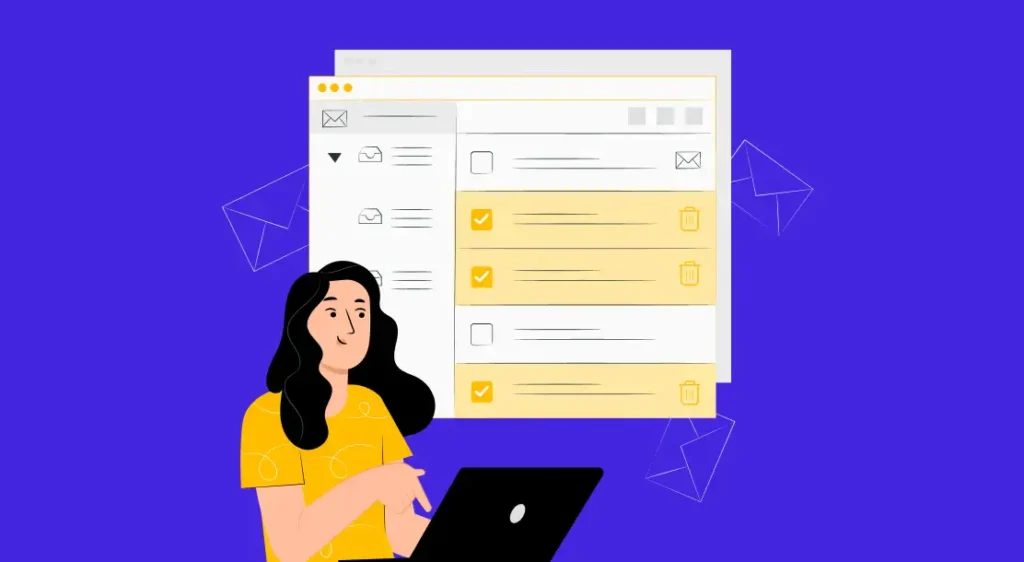How to Cold Email for Internship?
Cold emailing is a technique to reach out to someone you have never met before to start a professional relationship. In today’s world, cold emailing has become a crucial tool in the job search process. It’s an effective way to get in touch with potential employers and showcase your skills, experience, and eagerness to work with them.
Internships are essential for personal and professional growth, as they provide hands-on experience in a particular field and the opportunity to network and build a professional network.
This guide will dive into how to cold email for an internship, including crafting a catchy subject line and the essentials of a successful cold email. We will also provide templates and tips on finding the ideal person to contact and verifying their email address.
We will discuss the importance of personalizing your cold email and LinkedIn search operators and how to use relevant filters to find the right companies and opportunities.
By the end of this guide, you will have a better understanding of the cold emailing process, and you’ll be able to craft your cold email for an internship confidently. It doesn’t matter if you’re looking for paid or unpaid internships.
This guide will provide all the preliminaries you need to kickstart your job search and land your dream internship.
Preparation for an Effective Cold Emailing Campaign
Cold emailing can be an effective way to find internship opportunities, especially if you’re not having luck with more traditional methods. With the proper preparation, you can create a solid initial cold email that will catch the attention of hiring managers and help you get your foot in the door.
Here are some critical steps to consider as you prepare for your cold emailing campaign.
1. Research the Company and the Industry
Before you craft your cold email, it’s important to do your research. Find out as much as possible about the company you’re interested in and the industry. This will give you a better understanding of what the company is looking for in an intern and help you tailor your email to their specific needs. To do so, you can use various job boards, such as Jooble, to learn about available job openings for onsite and online internships that may be of your interest and requirements of the companies who hire.
2. Identify the Right Contact
You’ll want to ensure you send your cold email to the right contact. Look up the company’s website and LinkedIn profile, and see if you can find an HR manager or someone in a similar role. If you’re still unsure who to contact, contact the company directly and they will direct you to the right person.
3. Determine the Purpose of the Email
Before you write, it’s critical to know why you’re emailing. What do you hope to achieve with this cold email campaign? Are you looking for a paid internship or just trying to get your foot in the door? Knowing your goals will help you create a clear and focused message.
4. Create a Strong Subject Line
The subject line is the first thing the recipient will see, so making a good impression is essential. Ensure your subject is catchy and relevant to the purpose of the email. A strong subject line can be the difference between a successful cold email and one that goes straight to the trash.
5. Create a Professional Email Address
Finally, make sure you’re using a professional email address. This will help you look more credible and increase the chances of your email being taken seriously. Before sending cold emails, consider setting up a professional email account for your job search.
This will also help you keep track of your communications and ensure that your email address stays professional and up-to-date.
How to Cold Email for Internship—Understanding the Company Culture
Cold emailing can be an effective way to reach out to companies and get an internship opportunity, but it is important to understand the company culture before crafting your email. This section will discuss researching a company and personalizing your cold email for an internship.
1. Research the Company’s Values and Mission
Before cold emailing, take some time to research the company, its values, and its mission. Look into the company’s recent projects, news, and achievements, and familiarize yourself with the company’s tone and language.
This will help you understand the company’s target audience and tailor your email to match their style.
2. Verify the Email address before sending a cold email
It is crucial to understand to who you are sending the cold email. Include relevant contact details and verify them using email verification tools. By using these tools, you can ensure that your email will reach the identified person and increase your chances of getting a response.
3. Personalize Your Cold Email
Use a catchy header and a professional tone to make your cold email stand out. You can also use a cold email template as a guide, but you must personalize it to fit the recipient and the company. Remember to keep the email concise and to the point, avoiding email etiquette sins such as writing a whole life story or attaching your resume without prior connections.
4. Follow Up
After sending your cold email for an internship, wait for a response and be prepared to follow up if necessary. A follow-up can increase your response rate and help start a meaningful conversation. Make sure that you give enough time to the recipient and don’t send a follow-up too early.
Identifying the Right Person to Contact for Cold Emails
Cold emailing can be a powerful tool in the professional world but ensuring that your email lands in the right hands are essential. To increase your chances of success, you need to know how to identify the right contact when you’re cold emailing for an internship.
Here are some tips to help you get started:
Research the Company’s Organizational Structure
The first step in identifying the right contact is researching the company’s organizational structure. Look for the relevant department or team that fits your career goals, and use LinkedIn, the company’s website, or other sources to find the right person.
Usually, a company’s LinkedIn page has got a list of employees working there. Also, there are several tools that can help you extract an email address from a LinkedIn profile or business website easily.

Determining the Purpose of the Email
As you start crafting your cold email for an internship, it’s crucial to determine the purpose of the email. This will guide you as you write the subject line, body, and overall tone of the email.
Understanding the intention of your cold email will also increase the chances of it being successful and getting a response.
Here are a few things to consider when determining the purpose of your cold email:
Explain why you are interested in the company and the internship opportunity. This can include highlighting recent news, such as the company raising money or personal interest in the industry.
Highlight your relevant skills, experiences, and qualifications. This will help convey why you are a good fit for the company and the internship.
Express your enthusiasm for the company and the role. This will show that you are genuinely interested and passionate about the opportunity.
Convey why you are a good fit for the company and the internship. This can include discussing relevant student organizations, past internships, or job opportunities.
Creating a Compelling Subject Line

When cold emailing for an internship, it’s crucial to get the subject line right. After all, it is the first thing a hiring manager will see determining whether they open your email.
Here are a few tips to help you craft a successful cold email subject line:
1. Make it Clear and Concise
When crafting a cold email subject line, it’s important to make it clear and concise. Highlight the purpose of the email in just a few words to grab the reader’s attention and entice them to open your email.
2. Use Relevant Keywords
Incorporating keywords related to the company and the opportunity is key to creating an effective cold email subject. This shows that you’ve researched and are genuinely interested in the position.
3. Avoid Over-the-Top Punctuation
Avoid using all caps or excessive punctuation in your internship email subject. This can come across as unprofessional and may cause your email to be filtered as spam.
4. Implement Relevant Filters
To create standout cold email subject lines, consider implementing proper filters such as the hiring process, recent money raised by the company, or top venture capital investors. Mentioning your current company, your strong resume, or your involvement in student organizations can make your email more attractive.
5. Make it Attention-Grabbing
Your cold email subject lines should grab the reader’s attention and give them a reason to open your email. Make it compelling, and remember that a good subject line can make all the difference in securing that internship you’ve been seeking!
Examples of Effective Cold Email Subjects
The subject is crucial when it comes to cold emailing for an internship. It sets the tone for the entire email and can distinguish between a recipient opening and responding to your email or ignoring it.
Here are three subject lines that have proven effective for cold emailing for internships.
“Inquiring about the [Position] at [Company]”
This straightforward subject gets straight to the point. The recipient knows exactly why you’re reaching out and shows your interest in working at their company. This approach is direct and professional, making it a great option for those looking to impress a potential employer.
“Recent Graduate Seeking Internship at [Company]”
This catchy subject line emphasizes your qualifications and recent graduation in a specific field, making it clear that you’re the right fit for the position and that you have a particular skill set making you an excellent fit for the internship you’re interested in.
This can make your email stand out in a crowded inbox and show the recipient that you’ve done your research.
“Passionate About [Industry]”
This internship email subject line showcases your passion and enthusiasm for the industry and the specific company you’re reaching out to. By highlighting your passion, you’re showing the recipient that you’re not just looking for any kind of internship.
It shows that you are specifically interested in working with this company and in this field. This approach can help build rapport with the recipient and increase the likelihood of them responding to your email.
When crafting your cold email subject line, ensure it’s concise, clear, and relevant to the recipient. Remember, the goal is to get the recipient to open your email and respond, so make it a subject line that they can’t resist.
With these three examples, you can make a great first impression and take one step closer to landing your dream internship!
Crafting the Cold Email Body and Using the Right Tone
When crafting cold emails, it’s crucial to get the body of the email just right. Whether you’re cold-emailing for an internship or trying to connect with someone in the business world, the right tone and language can make all the difference.
Start with a Professional Greeting and Mention the Purpose of the Email in the First Paragraph
Most successful cold emails for internships begin with a professional greeting, such as “Dear [Name]” or “Hello [Name].” This sets the tone for the rest of the email and shows that your email isn’t there to conduct business or push sales.
In the first paragraph, mention the purpose of the email. Whether you’re reaching out for an internship opportunity or to follow up. Be clear and concise about why you are reaching out. The first few lines will make a huge difference in the outcome of your email. Make sure that you personalize and tailor these lines to fit each specific recipient.
Highlight Your Relevant Skills, Experiences, and Qualifications
In the second paragraph, highlight your relevant skills, experiences, and qualifications. Explain why you are a good fit for the opportunity or the company you’re reaching out to. You can also include a recent raise in funding or attach your resume to give the recipient more information about your background.
Explain Why You’re Interested in the Company and the Internship
In the third paragraph, explain why you are interested in the company and the internship opportunity. Show genuine interest and enthusiasm for the opportunity, and convey confidence in your skills and qualifications.
Close the Email with a Call to Action and a Professional Signature
End your cold emails with a call to action, such as asking for a quick call or a meeting. Include a professional signature with your name, title, and contact information.
Using the Right Tone and Staying Focused on the Purpose of the Email
When writing cold emails, it’s essential to use a professional and courteous tone. Avoid slang or overly casual language, and show genuine interest and enthusiasm for the company and the opportunity. Convey confidence in your skills and qualifications.
It’s important to stay focused on the purpose of the email and avoid going off-topic. Keep the email concise and to the point, and ensure the purpose is clear and easy to understand. This will help increase your response rate and lead to successful cold emailing experiences.
Check for Spelling, Grammar Errors, Structure, and Readability
Proofreading and editing are the most critical steps in crafting successful cold emails. Whether you’re sending a cold email to inquire about an internship opportunity or to follow up on a recent conversation, your email must be professional, free of mistakes, and easy to read.
Check for any spelling and grammar errors before emailing. A well-structured cold email free of typos and mistakes is more likely to be taken seriously by the recipient.
Next, make sure the email is well-structured and easy to read. A perfect cold email template is a great starting point, but it’s important to personalize it and make it specific for each person. Consider using headings and bullet points to break up the text and make it easier to read.
Make a Great First Impression
When sending a cold email for an internship, it’s important to remember that you’re making a first impression. Successful cold emails can lead to future conversations and potentially even a job offer, so take the time to ensure your email is perfect.
Follow Up to Increase Response Rates
Don’t forget to follow up! Follow-ups are often the key to unlocking the door to a successful internship with cold emails. Whether you’re sending an unsolicited email to large companies or a follow-up to a recent conversation, a well-crafted follow-up mail can increase your response rates.
Following up on your Cold email about the Internship
Regarding cold emailing, following up can make or break your chances of landing an internship. Here are some best practices to help you follow up effectively:
It’s Good to Wait for a Response Before Following Up
It’s always a good idea to wait for a response before sending a follow-up email. Many professionals receive a large volume of cold emails, and it’s understandable if they need time to review and respond to each one. A reasonable wait time is around 3-5 business days before following up.
Use a Polite and Professional Tone in the Follow-Up Email
When sending a follow-up mail, it’s important to maintain a polite and professional tone. Remind the recipient of the purpose of the original email, express your enthusiasm for the opportunity, and reiterate your interest in the internship. Be concise and to the point, and avoid using a brute-force email approach.
Reiterate Your Interest
In your follow-up email, mention your recent search results for actively hiring companies and why the internship format would be a good fit for you. If you have any personal blogs or more relevant experiences to share, include them in your email. This will help the recipient remember who you are and why you’re contacting them.
Use the follow-up to show your enthusiasm for the opportunity and reiterate your interest. Doing so will increase your chances of landing the internship and standing out from the rest of the applicants.
Personalizing Your Cold Emails
Cold emails are a powerful tool for finding an internship, but only if they are done right. Here are some tips for personalizing your cold emails to help increase your chances of success.
Use the Recipient’s Name
Using the recipient’s name in the greeting and throughout the email can significantly affect the response rate. Research has shown that people are more likely to respond to emails that address them by name. Try finding the person’s email address through search results or a contact list.
Mention Something Specific About the Company and Show How Your Skills and Experiences Fit
Mentioning something specific about the company or the opportunity that appeals to you can also help increase the response rate. For example, if you’re writing a cold email for an internship, you might mention that the company recently got an award. This shows that you have researched and are genuinely interested in the opportunity.
In your cold email, show how your skills and experiences are a good fit for the company and the role. For example, you could mention a specific project you worked on that applies to the internship.
Convey Your Genuine Interest
Finally, convey that you have researched and are genuinely interested in the opportunity. This can help increase the response rate and make the recipient feel more positive about your email.
You cannot use generic emails to convey your genuine interest. Therefore, you must personalize each email and make it unique. To save time you can automate the personalization and send your cold emails with Nureply.
Importance of a Call to Action
A call to action (CTA) is a crucial aspect of your cold email when applying for an internship. A CTA is a final push that can make or break your chances of securing an opportunity. The primary goal of your email is to encourage the recipient to take action and schedule an interview with you.
This is why clarifying the next step and what you would like the recipient to do is vital.
Express Your Eagerness to Hear Back
In your cold email, it’s essential to express your eagerness to hear back from the recipient. Tell them you’re looking forward to discussing the internship and how you can add value to the company.
When crafting your CTA, make sure it’s clear and specific. For example, you could write, “I would love to schedule a call with you to discuss the internship opportunity further. Could we set a date and time that works best for you?” The recipient should clearly understand what you want from them and the next steps.
Professional Signature for Internship Example

You want to make a great first impression in reaching out to potential internship employers. This starts with your email signature.
In this section, we’ll cover what you should include in your signature, how to make it professional, and how to ensure it’s easy to read.
Include Your Full Name, Email Address, and Phone Number
Your full name, email address, and phone number should be included in your signature. This allows the recipient to easily get in touch with you, as well as to identify you. Make sure to use a professional email address rather than a casual one.
For example, instead of “cutiepie123@gmail.com,” you should use “firstlast@gmail.com.”
Include Links to Your LinkedIn or Personal Website
Including a link to your LinkedIn profile or personal website can help the recipient better understand who you are and what you’re about. This is especially important when you’re reaching out for an internship, as the recipient will want to see your qualifications and experience.
The signature should be easy to read and professional. Avoid using overly fancy fonts or excessive amounts of colors. Keep the design simple and use plain text to make it look clear. You want the recipient to be able to quickly see the information they need without having to wade through a lot of clutter.
Templates for Cold Emails for an Internship and How to Customize the Templates
Using a template can be a helpful starting point regarding cold emails for an internship. However, it’s important to customize each email you send to make it feel personal and tailored to the recipient.
Here are some tips to help you personalize your templates and make a strong impression.
Replace the Placeholder Text with Your Information
The first step to customizing your templates is to replace the placeholder text with your information. This includes your name, contact information, experience, and other details that make your email unique. Make sure that all of the information you include is accurate and up-to-date.
Personalize the Templates Based on Your Research on the Company
Before sending any cold email, you should research the company and the opportunity. This will help you understand what the company is looking for in an intern and what they want to accomplish with the internship program.
Use this information to personalize your email and make it clear that you genuinely are interested in the opportunity.
Common Mistakes to Avoid

Writing cold emails for an internship can be challenging, but with the right approach, you can increase your chances of success. Here are some common mistakes to avoid when writing emails for an internship:
Using an unprofessional email address:
An email address such as “ilovepuppies1234@gmail.com” may not inspire confidence in the recipient. Make sure to use an email address that is professional and reflects your name.
Using vague or misleading subjects:
A subject that is vague or misleading can cause your email to be overlooked or marked as spam. Be clear and concise in your subject lines, and ensure it accurately represents your email’s content.
Failing to personalize the email:
A generic email sent to multiple recipients can be impersonal and unprofessional. Take the time to research the company and the recipient and tailor your email to their specific needs and interests.
Going off-topic or including excessive information:
Keeping your email focused and to the point can increase the likelihood of a response. Avoid going off-topic or including excessive details irrelevant to the recipient.
Failing to proofread and edit the email:
Proofreading and editing your email is essential. Double-check for typos, grammatical errors, and other mistakes that can detract from the professional tone of your email.
How to Respond to Rejection
Receiving a rejection letter can be discouraging, but it’s important to remember that it’s just a step toward success. Maintaining a professional and positive attitude is the key to responding to rejection.
Here are some tips for responding to rejection to make you stand out.
Express gratitude:
Express your appreciation for the opportunity to apply for the internship. Mention how you appreciate the time and effort the organization has put into the selection process.
Ask for feedback:
Ask for constructive feedback on your application or suggestions for future opportunities. Show that you are eager to learn and improve and that you value the opinions of others.
Keep a positive attitude:
Don’t take the rejection personally. Remember that rejection is a normal process and does not reflect your worth. Keep a positive attitude and look for other opportunities aligned with your goals and aspirations.
Move forward:
Finally, it’s important to move forward and not dwell on the rejection. Focus on your goals and continue to work towards them. Use the feedback to improve, grow, and keep an open mind to new opportunities.

Conclusion
Writing cold emails for an internship can be a highly effective way to gain valuable experience and kick-start your career. Following the guidelines and suggestions provided in this guide can increase your chances of success and make a positive impression on potential employers.
Remember to keep your emails professional, friendly, and helpful. Showcase your skills, enthusiasm, and dedication, and don’t be afraid to ask for an opportunity to further discuss your potential contribution to the company.
Cold emails can be a powerful tool in your job search and internship, and with a little effort and persistence, you can land the opportunities in companies you always wanted to work with.


